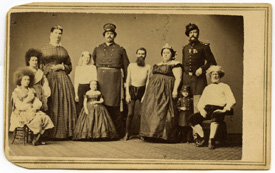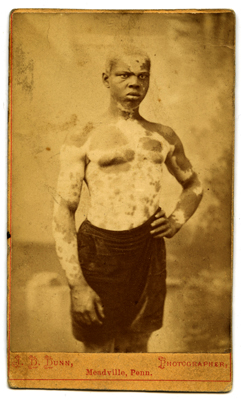
Nathan T. Burrows
Frontiers: Figure 1
Subject: Nathan T. Burrows
Maker: J. H. Dodge (Boston)
Genre: studio portrait
Process: carte de visite, albumen print
Date: circa 1865
Collection: Greg French
We do not know more about the man sitting for this portrait other than his name, written on the back of the image: Nathan T. Burrows. He was probably a performer, as he poses here with various implements he could use, despite his lack of arms: in one foot he hold a pen and writes on a sheet of paper, an ink pot beside it. He must also have been able to shoot with the pistol propped up by the stool.

Performers in Barnum’s American Museuem
Frontiers: Figure 2
Subject: Performers in Barnum’s American Museuem
Maker: photographer unknown
Genre: studio portrait
Process: carte de visite, albumen print
Date: circa 1864-66
Collection: Greg French
The 19th century fascination with permutations of the human body extended as much to people ordinarily categorized as white as to people outside that grouping. P. T. Barnum (1810-1891), the great American huckster and showman, reserved a whole section of his American Museum in New York City for performers of this type and sold souvenir photographs such as this to the public. See the back of the photograph for identification of the performers, although many of these are stage names. Revenue stamps, such as the one on the back of this image, were used from 1864 to 1866 to raise funds to pay for the Civil War.

Family of albino performers
Frontiers: Figure 3
Subject: family of albino performers
Maker: Mathew Brady
Genre: studio portrait
Process: carte de visite, albumen print
Date: circa 1865
Collection: Greg French
This family of albinos were performers in a circus such as the one created by P. T. Barnum. The man might be Charles Gohren, who can be seen in Figure 2 in this slideshow. Note the strange ‘wild man’ costume he is wearing, including an animal skin skirt. This, together with his teased hair, was meant to display him as exotic, perhaps playing on the belief that alibinos were a more primitive form of white people. For an essay on the obsession with forms of primordial whiteness, see the essay <a href=”http://mirrorofrace.org/circassian/” target=”_blank”> “A Freakish Whiteness: The Circassian Lady and the Caucasian Fantasy”</a> on this site.

Miss Millie La Mar, Mind Reader
Frontiers: Figure 4
Subject: Miss Millie La Mar, Mind Reader
Maker: Obermüller and Kern (New York)
Genre: studio portrait
Process: cabinet photo, albumen print
Date: circa 1890
Collection: Gregory Fried
Albinos such as Miss Millie La Mar sometimes found work in circus sideshows; some believed that albinos’ extreme whiteness granted them supernatural powers, and the circus exploited such superstitions. Nothing more is known about Miss La Mar at the moment, but if any viewers have further information, we would welcome anything that can be documented.

Mungo Park: The Spotted Boy
Frontiers: Figure 5
Subject: Mungo Park: The Spotted Boy
Maker: J. D. Dunn (Meadville, Pennsylvania)
Genre: studio portrait
Process: carte de visite, albumen print
Date: circa 1875
Collection: Greg French
According to the account on the back of this photograph, Mungo Park was found in 1868 in South Africa. Modern medicine would probably identify his condition as vitiligo, which causes the skin to lose pigmentation, but in the 19th century, when no one understood its scientific cause, there was a fascination with cases where dark-skinned people seemed to be turning as white “as the skin of the fairest Caucasian,” as W. H. Vosper writes here. Such cases caused anxiety, because they suggested that “colored” people might become white, or that skin color could be an accidental rather than an essential feature of a person’s physiognomy. This undermined the notion of clear division between the races.. Vosper was a photographer operating in Sydney, Australia; this is possibly a copy photograph by J. D. Dunn.

Miss Halleon, American Bearded Lady
Frontiers: Figure 6
Subject: Miss Halleon, American Bearded Lady
Maker: photographer unknown (Meadville, Pennsylvania)
Genre: studio portrait
Process: carte de visite, albumen print
Date: circa 1865
Collection: Gregory Fried
The back on this photograph reads, “Miss Halleon, American Bearded Lady, age 28, Castile, Wyoming County, N.Y.” Like Mungo Park, the “Spotted Boy” in the previous slide, the “bearded lady” was also a cause of fascination for the Victorian imagination. Both raised the disruptive possibility that what were assumed to be fixed and natural categories — race and sex — might not be as stable as desired by the social structures that depended on these categories being defined, certain, and enduring. The color on this photograph was applied by hand in the photographer’s studio, and the image would have been used for marketing and for sales.
